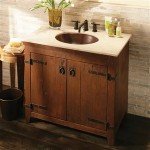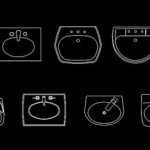How to Remove a Metal Ring Around a Bathroom Sink
A common aesthetic issue in many bathrooms is the presence of a metal ring around the drain of the sink. This ring, often composed of mineral deposits, rust, soap scum, and other debris, can detract significantly from the overall cleanliness and appearance of the sink. Removing this ring can be a straightforward process, but it often requires patience and the proper tools and cleaning agents. This article will detail several methods for removing this ring, ranging from gentle, everyday cleaning solutions to more aggressive approaches for stubborn stains.
Identifying the Composition of the Ring
Before initiating any cleaning process, it is crucial to identify the composition of the ring. Understanding what the ring is made of will dictate the most effective cleaning approach. Common components include:
- Hard Water Deposits (Calcium and Magnesium Carbonate): These deposits, often appearing as a chalky white or light brown residue, are caused by minerals present in hard water.
- Rust (Iron Oxide): Rust can appear as a reddish-brown stain and indicates corrosion of metal components in the drain assembly.
- Soap Scum: This is a combination of soap residue and minerals, typically appearing as a grayish or white film.
- Mold and Mildew: In damp environments, mold and mildew can contribute to the ring, often resulting in a dark or greenish discoloration.
Identifying the primary component(s) of the ring will help in selecting the most appropriate cleaning agent. For instance, hard water deposits respond well to acidic cleaners, while rust requires rust removal products.
Gentle Cleaning Methods
The initial approach to removing the metal ring should always involve gentle cleaning methods. This minimizes the risk of damaging the sink's surface, especially if the sink is made of delicate materials such as porcelain or enamel.
1. Hot Water and Mild Dish Soap: This is the simplest and often most effective first step. Hot water helps to loosen the debris, while mild dish soap acts as a surfactant to lift the dirt away. Apply hot water and soap to the affected area, let it soak for a few minutes, and then scrub gently with a soft sponge or cloth. Rinse thoroughly with clean water.
2. Baking Soda Paste: Baking soda is a mild abrasive that can effectively remove surface stains and soap scum. Create a paste by mixing baking soda with a small amount of water. Apply the paste to the ring, let it sit for 15-20 minutes, and then scrub gently with a soft brush or sponge. Rinse thoroughly with clean water.
3. Vinegar Soak: Vinegar is a mild acid that can dissolve hard water deposits and soap scum. Soak a cloth or paper towel in white vinegar and place it directly on the ring. Allow the vinegar to sit for at least 30 minutes, or even overnight for stubborn stains. After soaking, scrub gently with a soft brush or sponge and rinse thoroughly with clean water. For vertical surfaces, saturate a paper towel and adhere it to the area.
4. Lemon Juice: Similar to vinegar, lemon juice contains citric acid, which can dissolve mineral deposits. Apply lemon juice directly to the ring, let it sit for 30 minutes, and then scrub gently. Rinse thoroughly with clean water. The natural acidity of lemon juice also provides a pleasant fragrance.
If these gentle methods prove insufficient, proceed to more aggressive cleaning techniques.
More Aggressive Cleaning Methods
When gentle cleaning methods fail to remove the metal ring, more aggressive techniques may be necessary. These methods involve stronger cleaning agents and more abrasive tools. It is crucial to exercise caution when using these methods to avoid damaging the sink's surface or drain components.
1. Commercial Bathroom Cleaners: Numerous commercial bathroom cleaners are specifically formulated to remove soap scum, hard water stains, and rust. Choose a cleaner that is appropriate for the type of material your sink is made of (e.g., porcelain, stainless steel, acrylic). Follow the manufacturer's instructions carefully, paying attention to recommended dwell times and safety precautions. Always test the cleaner in an inconspicuous area first to ensure it does not damage the sink's finish.
2. Cleaning with Borax: Borax, also known as sodium borate, is a natural mineral with cleaning and disinfecting properties. Create a paste by mixing borax with water. Apply the paste to the ring, let it sit for 30 minutes, and then scrub gently with a sponge or brush. Rinse thoroughly with clean water. Borax is effective against mold, mildew, and soap scum.
3. Pumice Stone: A pumice stone is a mildly abrasive volcanic rock that can be used to remove stubborn stains. Wet the pumice stone and the affected area thoroughly before use. Gently rub the pumice stone over the ring, using a circular motion. Be careful not to apply too much pressure, as this can scratch the sink's surface. Rinse frequently with water. Pumice stones are best suited for porcelain sinks, as they may scratch other materials.
4. Rust Remover Products: If rust is the primary component of the metal ring, a dedicated rust remover product may be necessary. These products typically contain chemicals that dissolve iron oxide. Follow the manufacturer's instructions carefully, wearing appropriate protective gear (e.g., gloves, eye protection). Apply the rust remover to the ring, let it sit for the recommended time, and then scrub gently with a brush or sponge. Rinse thoroughly with clean water.
5. Using a Razor Blade (with extreme caution): As a last resort, a razor blade can be used to carefully scrape away stubborn deposits. Use a new, sharp blade and hold it at a shallow angle to the sink's surface. Gently scrape the ring, being careful not to gouge or scratch the sink. This method requires extreme caution and is only suitable for hard, non-porous surfaces like porcelain or stainless steel, and then only if you exercise meticulous care. Scratches can provide more surfaces for future deposits.
Tools for Effective Cleaning
The effectiveness of any cleaning method is enhanced by the use of appropriate tools. Here's a breakdown of tools that can aid in removing the metal ring:
1. Soft Sponges and Cloths: These are essential for applying cleaning solutions and gently scrubbing the affected area. Avoid abrasive sponges or cloths that can scratch the sink's surface.
2. Scrub Brushes: A small, stiff-bristled brush can be used to scrub stubborn stains and reach tight spaces around the drain. Choose a brush with synthetic bristles to avoid damaging the sink's surface.
3. Old Toothbrush: An old toothbrush is ideal for cleaning hard-to-reach areas and scrubbing crevices around the drain assembly.
4. Plastic Scrapers: A plastic scraper can be used to gently remove stubborn deposits without scratching the sink's surface.
5. Microfiber Cloths: These cloths are highly absorbent and effective at removing residue and polishing the sink after cleaning.
6. Gloves: Wearing gloves protects the hands from harsh cleaning chemicals and prevents skin irritation.
7. Eye Protection: Eye protection is essential when using strong cleaning chemicals to prevent splashes and potential eye damage.
Preventing Future Metal Ring Formation
After successfully removing the metal ring, taking proactive steps to prevent its recurrence is crucial. Implementing a regular cleaning routine and addressing the underlying causes of the ring's formation can significantly reduce the need for aggressive cleaning methods in the future.
1. Regular Cleaning: Wipe down the sink and drain area daily to remove soap scum and water deposits before they have a chance to build up. A quick wipe with a damp cloth after each use can make a significant difference.
2. Drying the Sink: Drying the sink after each use prevents water from evaporating and leaving behind mineral deposits. Use a clean, dry cloth to wipe the sink dry, paying particular attention to the area around the drain.
3. Using a Water Softener: If hard water is the primary cause of the metal ring, installing a water softener can significantly reduce the mineral content of the water, preventing the formation of hard water deposits. While this represents a larger investment, it provides benefits throughout the entire home.
4. Cleaning the Drain Regularly: Regularly cleaning the drain with a drain cleaner or a mixture of baking soda and vinegar can prevent the buildup of soap scum and other debris that contribute to the ring's formation.
5. Using Liquid Soap: Bar soap tends to leave more residue than liquid soap, contributing to the formation of soap scum. Switching to liquid soap can help reduce the buildup of residue around the drain.
6. Applying a Protective Coating: Applying a sealant or protective coating to the sink's surface can help prevent stains and make it easier to clean. Several commercial products are available that are specifically designed for this purpose. Follow the manufacturer's instructions carefully when applying these coatings.
By implementing these preventative measures, the bathroom sink can remain clean and free of unsightly metal rings, reducing the need for extensive cleaning and maintaining the overall aesthetic appeal of the bathroom.
Removing Bathroom Sinks Ceramic Tile Advice Forums John Bridge

How To Replace A Rusty Sink Drain Howtolou Com

How Do I Remove This Embedded Stain From Bathroom Sink Hometalk

How To Get Rid Of A Ring Around The Sink Drain Easily With Household Objects 6 Steps Instructables

How To Get Rid Of Iron And Rust Stains Once For All Water Right

How To Remove A Kitchen Sink From The Countertop

The Mystery Of Hootie Ring First Clues Uncovered Retro Renovation

How To Clean Ring Around Sink Drain 2 Ways Tested What Works

Complete Guide Fixing A Sink Stopper Step By Instructions

How Did I Get Rust Stains In My Sink Benjamin Franklin Dallas
Related Posts







